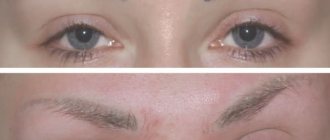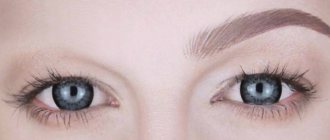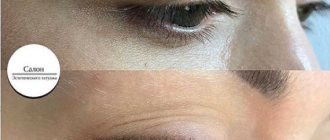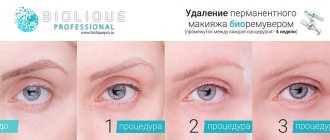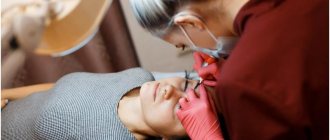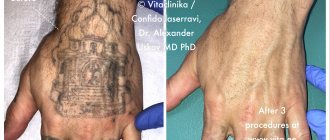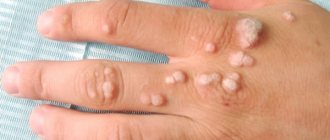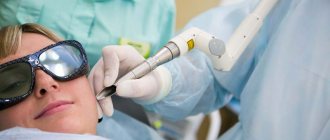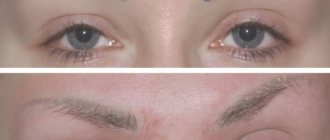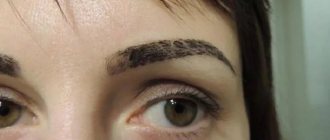From this article you will learn:
- Types of lasers for eyebrow tattoo removal
- Pros and cons of laser eyebrow tattoo removal
- Indications and contraindications for laser eyebrow tattoo removal
- Preparing for laser eyebrow tattoo removal
- How many sessions are needed and what determines the effectiveness of the procedure?
- Rehabilitation period
- Possible complications after laser eyebrow tattoo removal
- Incorrect laser tattoo removal of eyebrows
- What is better to choose for eyebrow tattoo removal: laser or remover?
- Is it possible to remove eyebrow tattoos using home remedies?
Not every time eyebrow tattooing ends successfully. Over time, defects may become noticeable in it, which are difficult to correct or disguise, and sometimes it is necessary to remove even the high-quality work of a master. In such situations, the laser eyebrow tattoo removal procedure will help.
Features of modern laser systems
In cosmetology, several types of laser devices are used to remove tattoos and tattoos, which differ in power and characteristics. To understand which pulse unit is best suited for removing facial tattoos, you need to understand their features:
- Ruby laser. Penetrates only 1 mm under the skin, which makes it impossible to remove deeply injected pigment. The ruby ray has a low speed and millisecond operating mode, which leads to burns and scars. In addition, this type of laser is distinguished only by black, blue, gray and green colors. Accordingly, it is not advisable to use it on the face.
- Alexandrite laser. It works a little faster than the ruby one, but is generally similar in characteristics to it. Distinguishes only dark shades, penetrates the skin to 1.8 mm. Leaves scars and burns. Not recommended for use on the face, as it requires future laser resurfacing of the treated skin areas.
- Diode laser. In cosmetology it is usually used for hair removal. This installation is capable of delivering power up to 100 J/cm²; in the hands of an inexperienced master, this is a real weapon. At 40 J/cm², the principle of selective photocavitation, that is, a selective effect on the pigment, is still preserved. With increasing power, not only pigment is removed, but tissue and blood vessels are also destroyed. The occurrence of colloidal scars in this case is inevitable, so this removal method should not be used for tattooing.
- Neodymium laser. The main difference from other lasers is the high speed of generation of pulsed beams, which allows for minimal impact on the skin. The 1064 nm infrared beam has the most effective effect on any dark pigments and works with any skin color. That is why the neodymium Q-switch laser is considered the best means of removing patterns from the lips, eyebrows and eyelids.
Having the necessary information about the principles of operation of laser systems, you can avoid falling into the hands of an unscrupulous specialist and keep your skin intact.
Tools for the procedure
Removal of unsuccessful tattoos is most often carried out using a neodymium laser. The device is a small unit with a display and a cooling system. It connects to a regular network. The beam reaches the deep layer of the dermis, affects the pigment capsules and splits them. They are subsequently eliminated by natural metabolism through the pores of the skin.
The laser removal kit includes various attachments, as well as special glasses for the laser operator and safety glasses for the client.
Description of technology
Removing coloring pigment from the eyebrows using a neodymium laser, which works on the principle of selective photocavication, allows you to remove previously applied tattoos in several sessions almost without leaving a trace.
The procedure for tattooing is as follows:
The laser beam, using ultra-short flashes lasting 3-5 nanoseconds, penetrates through the soft layers of the skin to a depth of 5-6 mm;- the laser passes through collagen and elastin, then through water and melanin;
- Upon reaching the pigment, the beam splits it into small particles.
One removal session takes about half an hour. In total, you will need from 3 to 6 visits to a specialist to achieve the desired result.
This method of influencing colored areas of the skin does not leave thermal burns, and also does not harm the structure of the hairs. After the procedure, the eyebrows become dull; they can be tinted in any available way.
Tattoo removal products
To remove eyelash tattoos, you can use sea and table salt. These two components are mixed in equal quantities to the consistency of a thick paste. Before applying the product, you should wash your eyes well and degrease your skin with micellar water. The prepared composition is applied for twenty minutes, after which it is washed off with warm water. The procedure is actually very long, it should be carried out as carefully as possible, avoiding getting salt into the eyes.
You can opt to remove pigment using iodine. The procedure should be done at least twice a day. Iodine should not be applied in a thick layer; if a strong burning sensation occurs, then the iodine must be removed with olive oil. As soon as two hours have passed after the procedure, you can apply a special healing cream to the treated area.
You can remove eye tattoos using hydrogen peroxide, but you should perform all actions as carefully as possible. Use a cotton pad slightly moistened with peroxide to treat the applied arrow on the eyelid. The procedure must be carried out at least five times a day for two months for the first results to become noticeable. Considering the fact that the skin of the eyelids is very delicate and thin, it is allowed to mix hydrogen peroxide with full-fat milk, you can even use cream.
All of the listed home methods do not provide a 100% guarantee of pigment removal, so it is still recommended to seek help from specialists.
Indications for use
The procedure for laser tattoo removal is carried out in a number of cases; the necessity and number of such operations will be determined by the specialist.
Typically the technique is used in the following situations:
- the shade of the applied pigment does not match the desired one;
- blurred areas or gaps appeared after tattooing;
- the result of the tattoo was unsuccessful: the shape is asymmetrical or does not suit the appearance;
- eyebrows faded several years after the last dyeing procedure.
Depending on the color of the pigment and the intensity of the color, the required number of removal sessions will be prescribed.
In what cases is it necessary to reduce pigment?
Keep in mind! Laser tattoo removal may be required in the following situations:
- The client no longer liked the eyebrows this way. Cosmetologists often hear that a person has no complaints about the work itself. But fashion has changed, and now either a different tattoo or no tattoo is required.
- The paint was chosen poorly. This problem occurs more often, since even an experienced specialist selects tones and shades “by eye” or according to special tables, mixing several dyes. But a lot depends not only on the accuracy of the proportions, but also on how the pigment will react with the skin and be distributed under it. And the color may not turn out the way you would like, and adjustments do not help fix it.
- Incorrectly selected shapes and contours . Sometimes the client does not listen to the specialist’s advice and insists that one form or another suits him better. At the same time, a person cannot perceive himself objectively. It’s even worse when the master and the client compromise, and then the result is something average, but in any case not what is needed.
- The eyebrows turned out to be asymmetrical . This could be either a mistake by the artist or the result of improper distribution of the pigment.
- There is constant pain in the tattooed areas. This phenomenon is rare, and it can be either a sign of a late-onset allergy or a reaction of overly sensitive tissues to the paint.
Note! Regardless of the reason, laser removal is not performed immediately on the day of treatment.
The specialist conducts a preliminary examination, offers possible solutions to the problem, and if they are truly absent, a date is set for the procedure .
Advantages of the method
Removing tattoos using a neodymium laser has a number of advantages compared to other chemical or home methods of getting rid of unwanted eyebrow coloring. Among the advantages of the technology:
- quick results, especially if the pigment was applied shallowly;
- no pain during the session;
- preservation of the hair structure and the upper layer of the epidermis;
- elimination of unaesthetic shape or color of eyebrows;
- complete disintegration of pigment capsules.
After each procedure, a recovery period is required, which lasts at least 2-3 weeks.
What is better to choose for eyebrow tattoo removal: laser or remover?
Removing permanent makeup from eyebrows is most often carried out using one of two methods:
- laser;
- using chemicals.
Each technique has both advantages and disadvantages. If the question arises about which method to choose for tattoo removal, you need to pay attention to a number of the following factors:
- quality, nature and chemical properties of the coloring matter;
- the depth of pigment penetration into the layers of the skin;
- quantity of available consumables;
- the quality of the devices used for applying pigment;
- professionalism of the master;
- individual characteristics of both the client’s skin and his entire body as a whole.
Patients should be explained that any method of removing annoying permanent makeup requires patience from them, since this process is not quick, and after the first procedure they will not see significant results.
Getting rid of tattoos using a remover is not much different from the process of applying it to the skin.
You must prepare for this cosmetic procedure as follows:
- a few days before the session, avoid drinking alcohol;
- two weeks before tattoo removal, do not do retinoic peeling;
- on the day of the procedure, stop taking medications that affect blood thickness and clotting;
- do not eat spicy food or seafood on the day of the session;
- A few days before visiting a cosmetologist, avoid visiting the solarium, swimming pool, bathhouse and gym.
The removal of eyebrow tattoo itself is carried out using the same device as the application.
The procedure takes place in several stages:
- Disinfection of the treated area.
- Pain relief (if the patient wishes).
- Applying a special preparation to the eyebrow area.
- Waiting for the composition to dry completely on the skin.
Before deciding what to choose for eyebrow tattoo removal: remover or laser, you need to familiarize yourself with the list of contraindications to the first:
- any acute illness;
- pathologies that slow down tissue regeneration (for example, diabetes);
- HIV infection;
- autoimmune disorders;
- infectious and non-infectious skin diseases (eczema, ichthyosis, mycosis, psoriasis, etc.);
- diseases of the blood coagulation system (hemophilia) or taking anticoagulants;
- malignant or benign neoplasms, especially in the area where manipulation will be performed;
- allergy.
Each girl must decide for herself which method of removing eyebrow tattoo is more acceptable to her. Below is a table that briefly and clearly describes all the features of each method.
If you don’t like the result, you don’t need to immediately run to remove your eyebrow tattoo with a laser or remover. There are many ways to correct an unsuccessful shape or color of permanent makeup. If you are simply tired of it or have gone out of fashion, try to find out in more detail how you can get rid of it, and be sure to find an experienced craftsman.
Read material on the topic: Laser hair removal of the upper lip: effective and reliable or expensive and useless?
Disadvantages of laser removal
Selective photocavitation is a rather complex procedure that requires a certain skill and level of professionalism. An unscrupulous specialist can cause skin burns. Other disadvantages of the method include:
- the need for several sessions;
- the high cost of each visit to a cosmetologist;
- a neodymium laser does not distinguish light pigment, which makes it impossible to remove some types of tattoos.
Sometimes it takes about two years to completely knock out the pigment. This is a fairly long period of time, during which you will have to periodically visit a specialist.
FAQ
Is it safe to use a laser to remove tattoos?
Absolutely. It does not injure the skin and gradually discolors the coloring matter.
Are there any contraindications to the procedure?
Yes, laser removal is not recommended for pregnant women, breastfeeding women, girls with diabetes, oncology or mechanical damage to the facial skin.
How many visits will it take to completely remove a tattoo?
Typically 2 to 4 visits are required. The amount depends on the saturation of the shade and the desired degree of removal.
Preparation for the procedure
During the session, the specialist must perform the following actions before starting the process:
conduct an explanatory conversation with the client about the principle of exposure to a laser beam;- remove all makeup;
- disinfect the required area;
- if necessary, anesthetize the skin;
- wear special safety glasses.
Clients should be aware of the duration of the procedure and how to properly care for their skin after laser correction.
Stages of the procedure
After completing the preparatory stage, the master proceeds directly to the tattoo removal procedure.
The specialist must exercise caution and high precision when working, since unprofessionalism can lead to burns and long-term non-healing scars.
The process goes like this:
- the master treats the desired area with disinfectants;
- puts on safety glasses for himself and the client;
- turns on the laser unit and affects the desired areas of the skin;
- the treated area is moistened with a special spray to relieve irritation, and a cooling pack is applied.
In some cases, a test procedure is required before removal begins. For example, in order to check how well a light pigment is removed.
You can see a clear example of exactly how a neodymium laser works on pigmented areas of the skin in the following video:
A laser eyebrow treatment specialist will tell you about all the nuances of the procedure, the correct procedure and possible side effects:
Restrictions
Sometimes the specialist does not recommend the laser technique to a girl, since the procedure can harm her even more.
Contraindications that must be observed:
- Pregnancy and lactation. Exposure to a laser can lead to side effects that affect the health of the expectant mother or child.
- Mechanical damage to the skin in the form of scars, large scratches or profuse rashes on the face. They will negatively affect the quality of tattoo removal.
- Cancer. Oncological diseases are an absolute contraindication to the procedure, as it can be dangerous to the girl’s health. Often, the use of a laser leads to a worsening of the disease.
- Diabetes.
- Blood diseases of infectious and non-infectious nature.
- Diseases of the heart and blood vessels.
- Autoimmune diseases.
- Age under 16 years.
It is worth observing contraindications, because in this case the likelihood of high-quality removal increases.
Sorokina Oksana
Cosmetologist
How many sessions will it take?
It is not always possible to accurately determine the time it will take to completely remove dyes from the skin. This depends on the following factors:
- pigment shade;
- pigment penetration depth;
- chemical composition of paint.
A certain period of time must pass between procedures so that the skin has time to recover before the next session.
The intensity of permanent makeup is reduced as much as possible after the first two procedures. Each subsequent impact will be less noticeable.
Most often, 3-4 visits to a beauty salon are required, sometimes more.
When is a tattoo removed?
Permanent makeup is removed if it has lost its relevance. Girls who decide to take such a step should clearly understand that the paint is based on mineral dyes that can last up to ten years. Therefore, first you need to find out how long eye tattoo lasts, and whether it will be fashionable in a couple of years. It should be remembered that after some time you will definitely have to either remove permanent makeup completely, or update it using new equipment and technologies, but be that as it may, you will still have to carry out the removal procedure.
Feelings during the session
Everyone's pain threshold is different, so each client describes the experience of laser correction in her own way. Some people feel only a slight tingling sensation, others find the pinpoint pain too difficult to bear even with anesthetic drugs.
Injections or topical medications are used to relieve pain. It is worth noting that none of the known methods of local anesthesia will completely desensitize the skin. You can only dull the unpleasant sensations.
Photo: before and after
Contraindications
Any salon procedure has its own nuances. Let's look at the main negative points why you shouldn't get an eye tattoo:
- First of all, it is worth noting that the procedure itself is not pleasant, and after it people may notice swelling of their eyelids.
- You need to find a really good master who will explain how to properly prepare for this procedure and introduce you to all the consequences that may result.
- It is important to remember that sooner or later, such changes in appearance may become boring, but to remove eye tattoos, the help of specialists may again be required.
- Before deciding to take such a step, it is necessary to carefully study all the contraindications, since the procedure is not recommended for people suffering from diabetes, with poor blood clotting, women who have a tendency to mental disorders, and, of course, those suffering from cancer.
If, however, the decision to get a tattoo is final, then you should definitely consult with a specialist and prepare properly.
Recovery period
Depending on the degree of exposure to the beam, the damage left by the procedure varies. In some cases, only mild swelling and redness appears, which quickly disappear. Sometimes small wounds appear from which blood oozes, but even in this case healing occurs in a short time.
The next day after the session, a crust appears, which is strictly forbidden to remove on your own. To avoid scars, you need to wait until the crust falls off.
The recovery period should last 2-4 weeks for complete regeneration of the deep skin to occur. If you do not maintain the required period, then with a repeated procedure, hematomas and severe swelling will form.
The main reasons for removing eye tattoos
Quite a lot of clients of beauty salons come to them just to remove eye tattoos. The main reason is that women fall into the hands of charlatans who do not know how to perform the procedure correctly, and in the end the result is not so rosy. In order to save money, careless cosmetologists use cheap materials of poor quality, which begin to blur when applied, which naturally affects the shape of the arrows. Sometimes it happens that an inter-lash tattoo turns out to be unsuccessful, and this happens because the specialist ineptly shades all the paint and the design turns out to be overly bright and is absolutely not suitable for the client.
Another commonplace reason why there is a desire to remove eye tattoos is related to the passing of fashion. The fact is that such long-term arrows can quickly become outdated before our eyes, and young people at the age of 20 always strive to keep up with the times.
Post-procedure care
After tattoo removal sessions, the master prescribes the necessary skin care measures. Among them:
touch the treated area as little as possible;- soak any protruding blood or ichor with a napkin;
- redness can be lubricated with Panthenol;
- Chlorhexidine or Miramistin should be applied to crusts and wounds.
It is strictly forbidden to go to a sauna or bathhouse in the first days after visiting a cosmetologist. In the first week, you need to avoid eyebrow makeup, as well as various peeling procedures, applying scrubs and masks. 3-4 months after tattoo removal, be sure to apply sunscreen before going out in the sun. This will help avoid pigmentation.
Possible complications
Hardware cosmetic procedures are fairly gentle methods of influencing the skin. Most clients do not experience any side effects other than mild redness of the skin. But sometimes complications can arise. The reason for this: the unprofessionalism of the master or the individual reaction of the body.
The following consequences are possible:
- pain during the session;
- redness, swelling of the skin;
- long recovery period;
- temporary lightening of eyebrow hairs;
- change in pigment color;
- scar formation;
- the occurrence of allergic reactions.
Among all the possible methods of tattoo removal, the laser method is considered the safest. Customer reviews are often positive.

